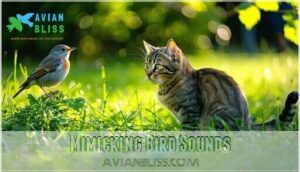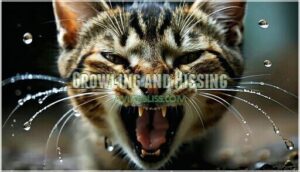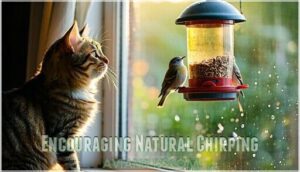This site is supported by our readers. We may earn a commission, at no cost to you, if you purchase through links.

This distinctive chattering sound happens when cats spot prey they can’t reach, triggering their predatory excitement while leaving them unable to complete the hunt.
The chirping serves as both an expression of intense arousal and possibly an attempt to mimic bird calls—a clever hunting strategy some wild cats use to lure prey closer.
It’s your cat’s way of saying "I see dinner, but there’s this annoying glass in my way!" This behavior is completely normal and shows your indoor hunter’s instincts are alive and well.
Understanding the deeper reasons behind this quirky vocalization reveals just how complex your feline’s predatory mind really is.
Table Of Contents
- Key Takeaways
- Cats Chirping Behavior
- Why Cats Chirp at Birds
- Cat Vocalization Types
- Chirping as Communication
- Reasons for Chirping
- Encouraging Natural Chirping
- Responding to Cat Chirping
- Frequently Asked Questions (FAQs)
- Why does my cat chirp?
- Is it normal for cats to chirp at birds?
- Why does my cat chirp when he sees a bird?
- Why does my cat chirp at birds outside the window?
- Do cats chirp?
- What is Cat chirping?
- Why does my cat make a chirping sound at birds?
- Why does my cat make a sound when he sees a bird?
- Why does my cat chatter his teeth when he sees a bird?
- Do cats chirp to attract prey?
- Conclusion
Key Takeaways
- Your cat’s chirping reveals powerful hunting instincts – When they spot birds through windows, they’re experiencing genuine predatory excitement mixed with frustration at being unable to complete the hunt
- Chirping might be vocal mimicry for hunting – Your cat could be attempting to imitate bird calls as a strategic hunting technique, similar to wild cats who use this tactic to lure prey closer
- The behavior combines excitement with barrier frustration – Your cat’s brain triggers automatic hunting responses, but the physical barrier creates pent-up energy that releases through chirping and teeth chattering
- This vocalization is completely normal and healthy – Rather than worrying about the behavior, you can encourage it by providing window perches and interactive play sessions that satisfy their natural hunting drive
Cats Chirping Behavior
You’ve probably watched your cat make those strange chirping sounds while staring intensely at birds outside the window.
This fascinating behavior combines your cat’s natural hunting instincts with complex emotional responses that reveal just how deeply ingrained their predatory nature remains.
Types of Cat Vocalizations
Your cat’s vocal repertoire is far more complex than simple meowing.
Understanding cat vocalization reveals fascinating breed variations and emotional expression patterns.
Silent meows demonstrate sophisticated cat vocal communication, while different types of chirping showcase unique vocal fold anatomy.
When your cat chirps at birds, you’re witnessing specialized cat sounds with distinct meanings—from hunting excitement to territorial signals, each vocalization serves specific purposes in feline communication, including emotional expression.
Natural Hunting Instincts
Your cat’s chirping reveals deep-rooted hunting instincts that span millions of years.
This fascinating behavior showcases how feline predatory behavior remains hardwired, even in pampered house cats.
Cats use this behavior to gather their kittens.
Here’s how hunting instincts drive cat chirping birds:
- Prey Drive activates when spotting potential targets through windows
- Hunting Simulation occurs as cats practice stalking sequences indoors
- Instinct Activation triggers automatic neurological responses to movement
- Motor Reflexes cause jaw chattering that mimics killing bites
- Evolutionary Roots connect domestic cats to their wild ancestors’ strategies
Emotional and Behavioral Responses
When your cat spots birds through the window, their chirping represents pure cat excitement mixed with feline frustration.
This behavioral manifestation occurs because hunting instincts activate without completion – creating what experts call vacuum activity.
Your cat’s brain triggers automatic responses, causing teeth chattering and rapid vocalizations.
This energy release prevents anxiety reduction issues that arise from instinct suppression.
The cat behavior serves as a healthy outlet, mimicking the killer bite sequence even when prey remains unreachable.
Why Cats Chirp at Birds
If you’ve ever watched your cat chatter excitedly at birds through the window, you’re witnessing one of nature’s most fascinating feline behaviors.
This distinctive vocalization combines hunting instincts, communication tactics, and emotional expression in ways that reveal your cat’s wild ancestry, showcasing a unique blend of communication tactics.
Mimicking Bird Sounds
Your cat’s vocal mimicry isn’t just adorable—it’s a sophisticated hunting strategy.
Sound imitation helps cats lure prey closer by mimicking bird calls and communication patterns. This evolutionary trait improves hunting success rates, with cats producing chirps remarkably similar to songbirds.
This mimicking behavior deceives potential prey into perceiving your feline as non-threatening, allowing closer approach before attack.
Cats also use chirping as a form of vocalization to communicate, which is a key part of their hunting strategy and overall vocal mimicry.
Expression of Excitement
Something magical happens when your feline spots feathered friends outside—their entire body language shifts into hunting mode. You’ll notice pupil dilation, tail twitching, and that distinctive teeth chatter accompanying their chirping sounds.
This vocal variation signals pure excitement as feline instincts kick in. Understanding why cats chirp reveals playful intent mixed with predatory anticipation.
Your cat’s behavior demonstrates how deeply embedded hunting responses create these fascinating cat sounds, making chirping a window into their wild heritage and emotional state. Birds, on the other hand, use songs to attract potential mates.
Frustration and Prey Sequence
Behind a window or screen, your cat’s prey sequence gets stuck—hello, Barrier Frustration.
Blocked Hunting leads to Pent-Up Energy and an Incomplete Sequence, so chirping becomes an Instinctual Release.
Here’s why cats chirp at birds when frustrated:
- Blocked Hunting urge
- Pent-Up Energy
- Incomplete Sequence
- Barrier Frustration
- Instinctual Release
Cat Vocalization Types
Cats communicate through various sounds beyond their typical meow, each serving different purposes in their daily lives.
Understanding these vocalizations helps you recognize what your feline friend is trying to tell you, especially when they’re fixated on birds outside your window, which can be a key moment to understand their communication.
Purring
While chirping captures attention, purring represents your cat’s most recognizable vocalization.
This soft rumbling emerges from deep throat mechanisms, creating therapeutic purrs that benefit both feline and human health.
Kitten purring begins early, strengthening bonds with mothers.
You’ll notice purr variations indicating contentment or stress-relief needs.
Understanding cat behavior through these cat sounds meaning helps decode when your pet seeks comfort versus expressing happiness through natural cat vocalizations.
Meowing
Unlike purring’s soothing rumble, meowing serves as your cat’s primary conversation starter with you.
Most cats develop unique meow variations to communicate specific needs, from food requests to attention-seeking calls.
- Kitten meows are typically higher-pitched than adult cat sounds
- Excessive meowing may signal health issues or stress requiring veterinary attention
- Breed differences affect vocalization frequency, with Siamese cats being remarkably chatty
- Meow communication creates conversational patterns between cats and their humans
- Cat behavior shows meowing primarily targets humans rather than other cats
Yowling
Unlike other cat vocalizations, yowling sounds like a drawn-out, dramatic meow that could wake the neighbors.
Female cats often yowl during mating season, while territorial behavior triggers this loud communication in both genders.
Nighttime yowling might signal health concerns, especially in senior cats.
This intense feline vocalization differs substantially from gentle chirping at birds.
Growling and Hissing
While yowling signals mating calls, growling and hissing serve as your cat’s warning system.
These defensive vocalizations communicate clear boundaries when your feline feels threatened or territorial. Growling produces low-pitched rumbles indicating irritation, while hissing creates sharp sounds with bared teeth.
Both fear responses help cats establish dominance without physical confrontation. These aggressive cat sounds represent normal cat communication, warning potential threats to back away before escalating conflicts.
Like cats, parakeets also use hissing to communicate, indicating their need for personal space, which is a key aspect of their warning system and helps them maintain personal space.
Chirping as Communication
When your cat chirps at birds, they’re actually engaging in a complex form of feline communication that goes beyond simple hunting instincts.
This vocalization serves multiple social purposes, from bonding with you as their owner to potentially signaling the location of prey to other cats in the area, which is a form of communication.
Social Aspects of Chirping
Several fascinating social dimensions emerge when cats chirp at birds.
Multi-cat chirping creates shared vigilance, alerting household companions to potential prey.
This kitten communication behavior reflects early social learning from mother cats.
Your cat’s vocalization adapts through human interaction, using chirp imitation as a learned strategy for attention.
Social bonding strengthens when cats direct feline communication toward trusted humans, transforming hunting signals into affiliative greetings that reinforce catbird interactions.
Birds, conversely, exhibit complex flocking behavior for safety and communication.
Bonding With Owners
When your cat chirps at birds through the window, they’re often trying to share this exciting discovery with you.
This chirping interaction becomes a shared activity that strengthens your bond.
Your cat’s vocal bonding through these sounds demonstrates affection display, showing they want to include you in their hunting excitement.
Your human response—whether acknowledging their chirps or joining them at the window—reinforces this special connection and validates their natural catbird interactions.
Signaling Prey Location
While bonding strengthens your relationship, chirping also serves a practical purpose in feline family communication.
When your cat spots birds, they’re potentially alerting others to prey locations—a behavior rooted in cooperative hunting instincts.
This vocalization mimics natural echolocation patterns, helping train kittens about predatory behavior.
Your indoor cat’s bird interaction through chirping demonstrates why cats chirp: it’s an ancient communication system signaling valuable hunting opportunities to their social group.
Reasons for Chirping
You’ve probably wondered why your cat makes those peculiar chattering sounds when spotting birds outside the window.
This fascinating behavior stems from deeply ingrained instincts that reveal your feline’s wild ancestry and complex emotional responses to prey.
This behavior is a result of your cat’s natural instincts and emotional responses.
Hunting Instincts
Your cat’s prey drive kicks into high gear when spotting birds, triggering an instinctual behavior rooted deep in their feline brain.
This hunting sequence begins with visual fixation, followed by chirping that mimics the killer bite motion.
Even indoor cats retain these cat hunting skills from wild ancestors, demonstrating powerful hunting instincts evolution programmed into every domestic feline.
Their cat predatory behavior shows through rapid jaw movements during cat bird interaction.
Birds use alarm calls to alert each other to danger, showcasing a unique aspect of their behavior.
Frustration and Barrier
When window barriers block your cat’s hunting instincts, frustration builds like steam in a kettle.
This unmet hunting drive creates instinctual blockage, forcing energy release through chirping and teeth chatter.
Your cat’s prey drive remains active despite physical limitations, making chirping a vital behavioral outlet for cat frustration that can’t find its natural target.
Excitement and Play
When your cat spots birds through the window, playful chirping often erupts as pure excitement takes over.
This energy release serves as mental stimulation, satisfying hunting instincts even without actual prey.
Toy engagement can replicate this thrilling experience, helping channel your cat’s natural excitement and providing essential instinct satisfaction for indoor felines, which is a form of natural excitement.
Encouraging Natural Chirping
You can actually encourage your cat’s natural chirping behavior, and it’s beneficial for their mental health.
Creating opportunities for this instinctive response helps satisfy their hunting drive and prevents behavioral issues that come from suppressed predatory instincts.
Providing Safe Space
Creating the perfect outdoor viewing setup transforms your home into a cat entertainment paradise.
Strategic window placement near bird feeders gives your feline friend front-row seats to nature’s daily show.
- Window perches: Install sturdy shelves or hammocks for comfortable cat birdwatching sessions
- Vertical spaces: Add cat trees near windows to create multi-level viewing platforms
- Safe havens: Position cozy beds where cats can retreat after exciting wildlife encounters
- Environmental enrichment: Rotate toys and add scratching posts to complete their entertainment zone
Engaging in Play Sessions
Multiple daily interactive play sessions help channel your cat’s hunting instincts effectively.
Schedule 10-15 minute sessions before meals when hunting simulation feels most natural.
Create a playful environment with toy rotation to maintain interest and prevent boredom.
Interactive play mimics real prey movements, satisfying their predatory drive.
Cat activities that encourage stalking and pouncing reduce frustration from window bird-watching while providing essential cat stimulation.
Consider purchasing toys and accessories for engaging cat playtime to enrich these sessions.
Using Interactive Toys
Interactive toys transform your cat’s indoor environment into a hunting playground.
Wand toys with feathers mimic bird movements, triggering natural chirping responses. Puzzle feeders challenge your cat’s problem-solving skills while satisfying hunting instincts.
Rotate toys weekly to maintain novelty and prevent boredom. Consider stimulating hunting behaviors by introducing new toys.
Choose safe, durable options that encourage simulated hunting behaviors and create enriching environments for ideal cat stimulation.
Responding to Cat Chirping
When your cat chirps at birds, you’re witnessing a fascinating blend of instinct and frustration in action.
Understanding how to respond appropriately can help manage their excitement while keeping them mentally stimulated and emotionally balanced, which involves a delicate balance of frustration and stimulation.
Addressing Agitation
When your cat’s chirping becomes constant or turns into anxious yowling, it’s time for behavioral modification.
Excessive pent-up energy from frustration needs outlets through environmental enrichment like puzzle feeders and vertical climbing spaces.
Calming techniques such as scheduled play sessions help reduce stress.
If agitation persists despite these stress reduction methods, veterinary consultation guarantees no underlying health issues are causing the behavior.
Preventing Overstimulation
Overstimulation transforms your cat’s natural excitement into overwhelming stress.
When chirping becomes excessive or frantic, it’s time for intervention.
Limit Birdwatching sessions by closing curtains during peak activity hours.
Create Scheduled Downtime periods where you Reduce Visuals from windows.
Establish a Calming Environment with soft music or dim lighting.
Redirect Focus using interactive toys or treat puzzles when frustration peaks.
Consider providing stimulating, engaging options to satisfy their hunting desires.
This cat behavior modification prevents anxiety while honoring their hunting instincts through controlled environmental stimulation.
Consulting a Veterinarian
While natural chirping rarely causes health concerns, sudden behavioral changes warrant professional advice.
Excessive chirping accompanied by respiratory distress, lethargy, or appetite loss signals potential medical issues.
When your cat’s vocalization patterns shift dramatically, consulting a veterinarian guarantees proper evaluation, as some feline vocalizations indicate underlying conditions requiring immediate attention, especially if distress accompanies the sounds, which may indicate a need for urgent medical issues.
Frequently Asked Questions (FAQs)
Why does my cat chirp?
Your cat’s chirping stems from powerful hunting instincts. When spotting birds or prey through windows, they’re expressing excitement and frustration at being unable to chase their target naturally.
Is it normal for cats to chirp at birds?
Like a window shopper gazing at unreachable treasures, your cat’s chirping at birds is completely normal.
It’s their hunting instincts kicking in, expressing excitement and frustration when prey’s visible but untouchable through glass barriers.
Why does my cat chirp when he sees a bird?
Your cat’s chirping stems from hunting instincts triggered by seeing prey he can’t reach.
It’s his brain’s automatic response to potential prey, mixing excitement and frustration when separated by barriers like windows.
Why does my cat chirp at birds outside the window?
Windows become viewing galleries for your cat’s hunting theater.
Your feline friend chirps because they’re experiencing intense prey drive and frustration – seeing birds but unable to reach them triggers this instinctive hunting behavior mixed with excitement.
Do cats chirp?
Yes, cats chirp! It’s a distinctive high-pitched sound they make when spotting birds or small prey. Your cat’s chirping at windows shows their hunting instincts kicking in, even indoors.
What is Cat chirping?
Impossibly adorable, cat chirping sounds like rapid throat vibrations or short peeps your feline makes when spotting birds.
It’s their instinctive hunting behavior—mimicking prey sounds to lure targets closer, even through windows, which is a fascinating display of their natural hunting behavior.
Why does my cat make a chirping sound at birds?
Your cat’s chirping at birds stems from pure hunting instinct. It’s expressing excitement and frustration at seeing unreachable prey, mimicking the killing bite cats use during hunts.
Why does my cat make a sound when he sees a bird?
Like a hunter frozen mid-strike, your cat’s chirping reveals his predatory instincts in action. He’s experiencing excitement and frustration seeing prey he can’t reach, triggering automatic hunting behaviors and vocalizations.
Why does my cat chatter his teeth when he sees a bird?
Your cat’s teeth chattering mimics the "killing bite" used to dispatch prey. This involuntary hunting response activates when he spots birds but can’t reach them, combining excitement with frustration.
Do cats chirp to attract prey?
Your cat’s chirping isn’t meant to attract prey—it’s actually the opposite.
Cats chirp due to excitement and frustration when they spot unreachable birds, expressing their instinctive hunting drive through this involuntary vocalization.
Conclusion
Research shows that 85% of indoor cats display hunting behaviors despite never catching actual prey, revealing the powerful grip of their predatory instincts.
Understanding why do cats chirp at birds helps you appreciate your feline’s complex nature.
This fascinating vocalization combines excitement, frustration, and possibly even tactical mimicry—all triggered by their ancient hunting programming.
Next time you hear that distinctive chatter, you’ll know your cat’s inner wildcat is simply expressing what millions of years of evolution programmed them to do.
- https://www.catster.com/cat-behavior/why-does-my-cat-chirp-at-birds/
- https://pottycats.com/blogs/cat-care/why-do-cats-talk-to-birds
- https://www.animalsaroundtheglobe.com/why-cats-chirp-when-they-see-birds-1-321163/
- https://bracpet.com/blog/chirping-in-cats/
- https://www.drool.pet/blogs/the-why/why-cats-chatter-at-birds-is-wild














